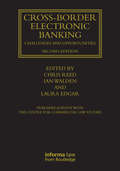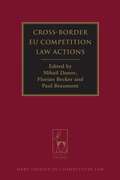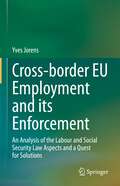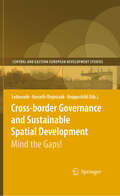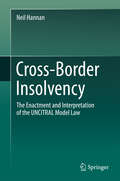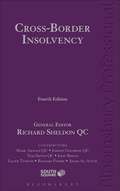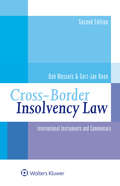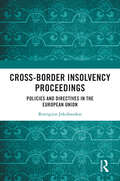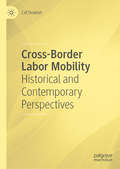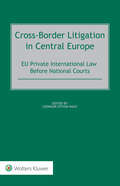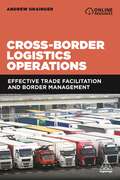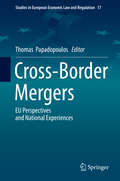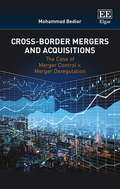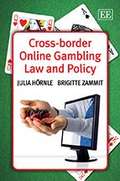- Table View
- List View
Cross-border Electronic Banking: Challenges and Opportunities
by Chris Reed Ian Walden Laura EdgarCross-border Electronic Banking addresses everything from the changes made to payment clearing since the deregulation of cross-border flows of funds, to the development of capital adequacy ratios and the Euro. This insightful and revealing book, backed up by extensive practical experience, will alert you to the ways that electronic banking practices affect even the simplest daily transactions, and will unveil the legal technicalities imposed by these developments.
Cross-Border Enforcement of Debts in the European Union, Default Judgments, Summary Judgments and Orders for Payment: Default Judgments, Summary Judgments and Orders for Payment
by Carla CrifòTo be enforceable, a foreign judgement needs some kind of ‘passport’ so that it can be given the same treatment as a judgement given at home. This is particularly true of monetary obligations. In Europe, the tension between the need for cross-border portability of such obligations and their enforcement, on the one hand, and sovereign states’ judicial control over enforcement of domestic and foreign judgements, on the other, has been addressed repeatedly by the European Court of Justice and the Commission and Council of the European Communities, most recently through the notion of ‘mutual trust.’ However, despite concerted efforts to establish some harmonization in this area, substantial divergences persist between the Member States’ procedural systems as regards the definition of an enforcement order, the procedures for enforcing judgements and, above all, the status, powers and responsibilities of enforcement officials. This major new exploration of the current status of cross-border enforcement of debts in Europe offers in-depth analysis of the most recent relevant regulation at the European Union level, as well as the default domestic regulation in England and Wales, Germany, France, Italy and Spain- five jurisdictions chosen due to the very thick web of relations they have had with each other as part of the established European order. The author provides detailed consideration of such elements of the legal landscape as the following: minimum standards for uncontested claims procedures; requirements as to service and information to be provided; extended safeguards of the creditor’s position and the rights of the defence; procedure for certification and for enforcement in the Member States of origin and of execution; and application, service and enforcement of a European Order for Payment. In the context of the intense academic and practical debate around what is being called ‘European civil procedure,’ this book contributes signally to the Commission’s stated objective of ensuring ‘as globally as possible a swift, efficient and inexpensive access to justice.’ The author details the procedural measures prescribed by the relevant directives (and their case law so far), and incidentally provides a convenient conduit to the appropriate material on the websites of the European Judicial Network and the Judicial Atlas in each jurisdiction. As lawyers continue, in the absence of ‘mutual trust’, to apply their own historic and philosophical meaning to the ‘harmonized’ procedures – no matter how much this approach is discouraged in the preambles to the regulations and directives – this book greatly illuminates the way forward in a difficult but extremely important area of European law.
Cross-Border Entry in European Retail Financial Services: Determinants, Regulation and the Impact on Competition
by Tobias C HoschkaProviding a comprehensive assessment of the strategies of banks and insurance companies in the move towards an internal European market for financial services, this book analyzes the latest theoretical and institutional developments. It also provides a range of case studies of actual cross-border entry strategies of some of the largest European financial institutions.
Cross-Border EU Competition Law Actions (Hart Studies in Competition Law)
by Mihail Danov Florian Becker Paul BeaumontThis book, written within the framework of a research project funded by the European Commission Civil Justice Programme, identifies the ways in which cross-border EU competition law actions can best be handled in Europe. Employing traditional library-based legal research methods as well as qualitative interviews with legal practitioners in Germany and England (countries sharing different legal traditions) and policy-makers in Brussels, the book considers how private EU competition law actions are functioning at the moment and how they could and should be developed. The study proposes solutions for some of the most pressing practical problems, and includes chapters by the following academics, legal practitioners and judges: Judge I Pelikánová (General Court of the EU); J Lawrence and A Morfey (Freshfields); P Lasok QC (Monckton Chambers); H Mercer QC (Essex Court Chambers); J Webber (Shearman & Sterling); T Reher (CMS Hasche Sigle, Germany); P Bos and J Möhlmann (BarentsKrans, the Netherlands); P Beaumont (Aberdeen); S Bariatti (Milan); G Howells (Manchester); D Fairgrieve (BIICL); J Fitchen (Aberdeen); A Andreangeli (Edinburgh); D Tzakas (Athens Bar, Greece); S Dnes (Sidley Austin, Brussels); F Becker and J Kammin (Kiel University, Germany); and M Danov (Brunel University).
Cross-Border EU Competition Law Actions (Hart Studies in Competition Law)
by Mihail Danov Florian Becker Paul BeaumontThis book, written within the framework of a research project funded by the European Commission Civil Justice Programme, identifies the ways in which cross-border EU competition law actions can best be handled in Europe. Employing traditional library-based legal research methods as well as qualitative interviews with legal practitioners in Germany and England (countries sharing different legal traditions) and policy-makers in Brussels, the book considers how private EU competition law actions are functioning at the moment and how they could and should be developed. The study proposes solutions for some of the most pressing practical problems, and includes chapters by the following academics, legal practitioners and judges: Judge I Pelikánová (General Court of the EU); J Lawrence and A Morfey (Freshfields); P Lasok QC (Monckton Chambers); H Mercer QC (Essex Court Chambers); J Webber (Shearman & Sterling); T Reher (CMS Hasche Sigle, Germany); P Bos and J Möhlmann (BarentsKrans, the Netherlands); P Beaumont (Aberdeen); S Bariatti (Milan); G Howells (Manchester); D Fairgrieve (BIICL); J Fitchen (Aberdeen); A Andreangeli (Edinburgh); D Tzakas (Athens Bar, Greece); S Dnes (Sidley Austin, Brussels); F Becker and J Kammin (Kiel University, Germany); and M Danov (Brunel University).
Cross-border EU Employment and its Enforcement: An Analysis of the Labour and Social Security Law Aspects and a Quest for Solutions
by Yves JorensThis book provides insights into the complex labour and social security framework of EU employment and its enforcement. Starting from an analysis of the various EU instruments and case law, it outlines the complicated legal framework, the practical problems involved, and ways to overcome them. In turn, the book puts the evolution of the framework into perspective, reviews the numerous modifications made over the years, and describes interpretation-related difficulties. Since the formation of the European Community 65 years ago, migration and the European labour market have evolved considerably through special patterns of (temporary) mobility such as postings, simultaneous work in several Member States and high mobility, thus leading to major questions about the applicable legal framework. The interplay between the free movement of persons and services has produced a complex system of rules. Which law applies when a person crosses a border: that of the host State (and to what extent should this State take into account the legal rules from the home State?) or that of the home State? Does the person crossing the border have any choice in the matter? The book subsequently analyses the penetration of EU (market) law into national systems of labour and social security law. The divergent solutions and views within labour and social security law are considered and discussed from a critical point of view. As the positive elements of the European story are at risk of being overshadowed by the negative consequences of the European construction – social dumping being the prime example – special attention is paid to the cooperation between inspection services and other stakeholders in order to guarantee efficient enforcement. The latter is more than just sanctioning, but also includes prevention and monitoring issues. The unique strength of this book is that it brings together all legal-technical aspects of cross-border employment and its enforcement in both labour law and social security law in a single volume. Readers will find a wealth of detailed and specialised information, helping them to understand the topic in depth. Accordingly, the book will be of interest to academics, practitioners, enforcement bodies, judiciary policymakers, advanced law students, and researchers seeking to understand the law in context.
Cross-border Governance and Sustainable Spatial Development: Mind the Gaps! (Central and Eastern European Development Studies (CEEDES))
by Markus Leibenath Ewa Korcelli-Olejniczak Robert KnippschildBorder regions in Central Europe undergo tremendous changes due to the enlargement of the European Union and the related processes of Europeanization, bordering and re-bordering. The book explores the consequences of these processes for cross-border governance and spatial planning in Central Europe. It combines analyses of European and national framework conditions with case studies from border regions and cities in 8 countries. The focus is on generic questions of cross-border planning and cooperation as well as on selected sectors such as nature conservation, transport and economic development. The book is written for the international scientific community and for practitioners in the fields of spatial planning, cross-border cooperation, environmental protection and structural policy.
Cross-Border Insolvency: The Enactment and Interpretation of the UNCITRAL Model Law
by Neil HannanThis book examines the effect of the adoption of the United Nations Committee on International Trade Law (UNCITRAL) Model Law on Cross-Border Insolvency in five common law jurisdictions, namely Australia, Canada, New Zealand, the United Kingdom, and the United States of America. It examines how each of those states has adopted, interpreted and applied the provisions of the Model Law, and highlights the effects of inconsistencies by examining jurisprudence in each of these countries, specifically how the Model Law affects existing principles of recognition of insolvency proceedings.The book examines how the UNCITRAL Guide to enactment of the Model Law has affected the interpretation of each of its articles and, in turn, the courts’ ability to interpret and hence give effect to the purposes of the Model Law. It also considers the ability of courts to refer to amendments made to the Guide after enactment of the Model Law in a state, thereby questioning whether the current inconsistencies in interpretation can be overcome by UNCITRAL amending the Guide.
Cross-Border Insolvency
by Richard Sheldon Qc Mark Arnold Qc Jeremy Goldring Qc Tom Smith Qc John Briggs Lloyd Tamlyn Richard Fisher Adam Al-AttarCross-Border Insolvency, fourth edition provides a comprehensive and up to date consideration of the topic of cross-border insolvency. Written in a clear and accessible manner it guides the user seamlessly through this complex area of law.The coverage of the book is divided into two parts. The first part describes the key cross-border insolvency regimes including the EC Insolvency Regulation, the UNCITRAL Model Law on Cross-Border Insolvency, section 426 of the Insolvency Act 1986, and the common law. The second part focuses on specific issues in more detail, such as the court's insolvency jurisdiction, ancillary winding-up, enforcement of foreign insolvency judgments, foreign discharge of debts and insolvency set-off. The fourth edition gives full analysis of the fundamental changes to cross border insolvency law and practice in England including:The impact of the Supreme Court decision in Rubin v Eurofinance;The revised UK Insolvency Rules;Proposals for revision of the EC Insolvency Regulation;Scope of section 426 – HSBC v Tambrook Jersey;Developments in offshore jurisdictions: Primeo Fund and Saad Investments (Cayman), Re C (BVI);Kelmsley v Barclays Bank PLC.Previous print edition ISBN: 9781845921040
Cross-Border Insolvency Law
by Bob Wessels Gert-Jan BoonRecent insolvency cases highlight the growing importance of cross-border insolvency matters in international transactions. In order to obtain relevant information essential for conduct in such transactions, an insolvency lawyer needs to have access to the many relevant instruments that have been introduced and implemented in recent years, but that until now have not been available in any single place. This very useful volume collects, for the second time in one source, all important international and regional legal instruments relating to insolvency of companies and consumers, as well as to corporate rescue law. The book includes international and regional conventions, model laws, EU regulations and directives, and guiding principles produced by various international bodies (such as the World Bank, the United Nations Committee on International Trade Law ('UNCITRAL'), the American Law Institute, INSOL International, and INSOL Europe), and international and European restatements of insolvency law by scholars. In addition to reproducing the complete texts of these instruments, the editors provide insightful commentary covering such important matters as the following: • key issues of each text; • expected amendments and revisions; and • comparative analysis of instruments. A unique resource bringing together core material in the field of cross-border insolvency law and legislation, this book will be welcomed by international insolvency practitioners worldwide.
Cross-Border Insolvency Proceedings: Policies and Directives in the European Union
by Remigijus JokubauskasThis book presents an analysis of the effectiveness of European Union cross-border insolvency proceedings. It provides a thorough assessment of the development of cross-border insolvency proceedings established in the Regulation on Insolvency Proceedings ((EU) 2015/848) and how they contribute to the general goals of the EU internal market. Insolvency law has not been subject to a global mandatory harmonization process, with no globally biding legal act. Instead, the landscape of international insolvency law is characterized by a patchwork of national laws that seek to accommodate cross-border insolvencies and soft law agreements. In the EU cross-border insolvency law holds significant importance in ensuring the smooth operation of the internal market. Fostering international investments and legal foreseeability in insolvency proceedings, it upholds the fundamental freedoms within EU law. This book covers the main elements of EU cross-border insolvency law, such as jurisdiction, applicable law, recognition and enforcement of judgments. It also focuses on previously unexplored areas, such as the exercise of creditors' rights in cross-border insolvency cases and the tracing and recovery of assets and discusses the application of the Restructuring and Insolvency Directive ((EU) 2019/1023) in relation to the rescue of viable companies and the discharge of debts for insolvent entrepreneurs. This book will be of interest to students and practitioners of insolvency law, EU law and private international law. It will also be useful for national legislators and EU institutions working on the development of EU insolvency law.
Cross-Border Insolvency Proceedings: Policies and Directives in the European Union
by Remigijus JokubauskasThis book presents an analysis of the effectiveness of European Union cross-border insolvency proceedings. It provides a thorough assessment of the development of cross-border insolvency proceedings established in the Regulation on Insolvency Proceedings ((EU) 2015/848) and how they contribute to the general goals of the EU internal market. Insolvency law has not been subject to a global mandatory harmonization process, with no globally biding legal act. Instead, the landscape of international insolvency law is characterized by a patchwork of national laws that seek to accommodate cross-border insolvencies and soft law agreements. In the EU cross-border insolvency law holds significant importance in ensuring the smooth operation of the internal market. Fostering international investments and legal foreseeability in insolvency proceedings, it upholds the fundamental freedoms within EU law. This book covers the main elements of EU cross-border insolvency law, such as jurisdiction, applicable law, recognition and enforcement of judgments. It also focuses on previously unexplored areas, such as the exercise of creditors' rights in cross-border insolvency cases and the tracing and recovery of assets and discusses the application of the Restructuring and Insolvency Directive ((EU) 2019/1023) in relation to the rescue of viable companies and the discharge of debts for insolvent entrepreneurs. This book will be of interest to students and practitioners of insolvency law, EU law and private international law. It will also be useful for national legislators and EU institutions working on the development of EU insolvency law.
Cross-Border Internet Dispute Resolution (PDF)
by Julia HörnleThe internet has the potential to increase the number of cross-border disputes between a wide range of different users. For many internet disputes, the use of Online Dispute Resolution (ODR) becomes critical. ODR uses information technology (such as expert systems) and internet communication applications (such as webforms or web filing platforms) to resolve disputes outside the courts. Although ODR is a progeny of ADR, using some of the same processes such as mediation and arbitration, ODR is also different in that it adds new and transformative technology and processes. This book sets out the process standards with which ODR, and in particular online arbitration, should comply and shows how these standards can be implemented in the real world. It considers applicable law and enforcement, thus providing a blueprint of how online arbitration processes should be devised.
Cross-Border Labor Mobility: Historical and Contemporary Perspectives
by Caf DowlahThis book presents a comprehensive review of cross-border labor mobility from the ancient forms of slavery to the present day. The book covers African and Amerindian slaveries, indentured servitude of the Indians and the Chinese, guestworker programs, and contemporary labor migration focusing on the United States, the European Union, and the Gulf Region. The book highlights the economics and politics that condition such trends and patterns by addressing growing anti-immigrant sentiments, as well as restrictive measures in the developed world, and outlines inexorable forces that are likely to propel further expansion of cross-border mobility in the future. This multidisciplinary volume provides a highly dependable scholarly reference to researchers, students, academics as well as policy makers.
Cross-Border Life and Work: Social, Economic, Technological and Jurisdictional Issues (Contributions to Management Science)
by Peter Droege Stefan Güldenberg Marco J. Menichetti Stefan SeidelThis book discusses the risks, challenges, and opportunities of cross-border work and life from a multidisciplinary and multilevel perspective, including (a) the individual, (b) the social and organizational, and (c) the regional levels, taking into consideration the diverse and multilayered social, economic, technological, and jurisdictional issues involved.Emerging public policies and advanced information technologies (IT) have created new opportunities for work and life that thrive in global value chains and markets. Life, in general, and work, in particular, are increasingly organized across borders of various kinds and are subject to rapid change. At the same time, life and work have been determined by 19th and 20th century infrastructures and technologies. As a consequence, new strategies and measures are required for both physical and virtual work and life spaces.
Cross-Border Litigation in Central Europe: EU Private International Law Before National Courts
Cross-Border Litigation in Central Europe EU Private International Law Before National Courts As a consequence of the ever-increasing intercourse within the enlarged and diverse European Union (EU), a growing number of businesses, consumers, and families rely on EU private international law instruments to seek justice in cross-border disputes. This invaluable reference book offers an in-depth understanding of this process in Central Europe and is the first to provide a comprehensive and analytical overview of the judicial practice in the region and to make this case law accessible in English. Presenting the results of a major EU-funded project (CEPIL), the book offers an insight into the reality of EU private international law and cross-border litigation in Central Europe: it provides a comprehensive and exhaustive presentation of the case law in 10 Central European Member States (Croatia, the Czech Republic, Estonia, Hungary, Latvia, Lithuania, Poland, Romania, Slovakia, and Slovenia); it covers all fields of EU private international law (general civil and commercial, insolvency, family and succession matters); it inquires whether EU private international law functions optimally in the Central European Member States in order to secure a Europe of law and justice; it examines whether EU private international law instruments are applied in a correct and uniform manner and whether national courts deal appropriately with disputes having a cross-border element; it analyzes whether the current legal and institutional architecture is susceptible of securing legal certainty and an effective remedy for cross-border litigants. This important practical resource helps businesses, consumers, families and legal counsels engaged in cross-border mobility to gain access to essential information and analysis as to the application and interpretation of EU private international law in Central Europe. The book is also highly valuable to academics and researchers specializing in private international law by presenting the research findings of the CEPIL project.
Cross-Border Litigation in Europe (Studies in Private International Law)
by Paul Beaumont Mihail Danov Katarina Trimmings Burcu YükselThis substantial and original book examines how the EU Private International Law (PIL) framework is functioning and considers its impact on the administration of justice in cross-border cases within the EU. It grew out of a major project (ie EUPILLAR: European Union Private International Law: Legal Application in Reality) financially supported by the EU Civil Justice Programme. The research was led by the Centre for Private International Law at the University of Aberdeen and involved partners from the Universities of Freiburg, Antwerp, Wroclaw, Leeds, Milan and Madrid (Complutense). The contributors address the specific features of cross-border disputes in the EU by undertaking a comprehensive analysis of the Court of Justice of the EU (CJEU) and national case law on the Brussels I, Rome I and II, Brussels IIa and Maintenance Regulations. Part I discusses the development of the EU PIL framework. Part II contains the national reports from 26 EU Member States. Parts III (civil and commercial) and IV (family law) contain the CJEU case law analysis and several cross-cutting chapters. Part V briefly sets the agenda for an institutional reform which is necessary to improve the effectiveness of the EU PIL regime. This comprehensive research project book will be of interest to researchers, students, legal practitioners, judges and policy-makers who work, or are interested, in the field of private international law.
Cross-Border Litigation in Europe (Studies in Private International Law #20)
by Paul Beaumont Mihail Danov Katarina Trimmings Burcu YükselThis substantial and original book examines how the EU Private International Law (PIL) framework is functioning and considers its impact on the administration of justice in cross-border cases within the EU. It grew out of a major project (ie EUPILLAR: European Union Private International Law: Legal Application in Reality) financially supported by the EU Civil Justice Programme. The research was led by the Centre for Private International Law at the University of Aberdeen and involved partners from the Universities of Freiburg, Antwerp, Wroclaw, Leeds, Milan and Madrid (Complutense). The contributors address the specific features of cross-border disputes in the EU by undertaking a comprehensive analysis of the Court of Justice of the EU (CJEU) and national case law on the Brussels I, Rome I and II, Brussels IIa and Maintenance Regulations. Part I discusses the development of the EU PIL framework. Part II contains the national reports from 26 EU Member States. Parts III (civil and commercial) and IV (family law) contain the CJEU case law analysis and several cross-cutting chapters. Part V briefly sets the agenda for an institutional reform which is necessary to improve the effectiveness of the EU PIL regime. This comprehensive research project book will be of interest to researchers, students, legal practitioners, judges and policy-makers who work, or are interested, in the field of private international law.
Cross-Border Logistics Operations: Effective Trade Facilitation and Border Management
by Andrew GraingerWith considerable turmoil in international trade and logistics it is more important than ever to understand trade and customs issues and their impact on logistics operations. At every port and border international freight operations are exposed to trade and customs procedures.Cross-Border Logistics Operations serves as a comprehensive guide and companion to the cross-border trade and customs environment and its implications for international business supply chains and their control. Inspired by the World Customs Organization's Professional Standards (also known as the WCO PICARD Standards), it provides key insights into transporting goods across borders and effectively managing the requirements for compliance and enforcement.International students, business operators and government officials will find the book rich in detail with practical examples that include the political, administrative, regulatory, technological and economic context throughout. It covers all the critical operational and legal aspects of cross-border logistics operations, including:-prevailing trade, customs and border policy-tariffs and import taxes -border management and supply chain security practices-prohibitions and restrictions-enforcement and compliance practices-supply chain and logistics arrangements-disaster relief operations-frictionless trade and trade facilitation principles.
Cross-Border Mergers: EU Perspectives and National Experiences (Studies in European Economic Law and Regulation #17)
by Thomas PapadopoulosThis edited volume focuses on specific, crucially important structural measures that foster corporate change, namely cross-border mergers. Such cross-border transactions play a key role in business reality, economic theory and corporate, financial and capital markets law. Since the adoption of the Cross-border Mergers Directive, these mergers have been regulated by specific legal provisions in EU member states. This book analyzes various aspects of the directive, closely examining this harmonized area of EU company law and critically evaluating cross-border mergers as a method of corporate restructuring in order to gain insights into their fundamental mechanisms. It comprehensively discusses the practicalities of EU harmonization of cross-border mergers, linking it to corporate restructuring in general, while also taking the transposition of the directive into account. Exploring specific angles of the Cross-border Mergers Directive in the light of European and national company law, the book is divided into three sections: the first section focuses on EU and comparative aspects of the Cross-border Mergers Directive, while the second examines the interaction of the directive with other areas of law (capital markets law, competition law, employment law, tax law, civil procedure). Lastly, the third section describes the various member states’ experiences of implementing the Cross-border Mergers Directive.
Cross-Border Mergers and Acquisitions: The Case of Merger Control v. Merger Deregulation
by Mohammad BedierThis book demystifies the dynamics of cross-border mergers and acquisitions; from the preliminary agreements and due diligence, to valuation, structuring, financing, and the eventual closing of the deal. It examines merger incentives and efficiencies, in theory and in empirical findings. The author adeptly identifies the impediments facing cross-border mergers and acquisitions and focuses on pre-merger control laws and regulations, particularly those of the US, EU, and Middle East. Consideration is also given to merger deregulation and other key reforming proposals. The book will be a useful resource for students and scholars with an interest in mergers and acquisitions, antitrust laws, and corporate history. Legal Professionals and those in related fields will gain a practical understanding of how to tailor their deals to overcome the unique impediments associated with cross-border transactions. Policy makers will also find the information and assessment criteria developed in the book to be a useful tool for evaluating and designing policy.
Cross-Border Mergers within the EU: Proposals to Remove the Remaining Tax Obstacles
by Harm Van den BroekAs a result of the Regulation on the European Company and the Tenth Council Directive, all Member States are obliged to finally implement the merger arrangements of the 1990 Fiscal Merger Directive, forcefully raising the question of the tax consequences of cross-border mergers. This book is the first to focus in such an extended way on the meaning of the 1990 Directive’s tax provisions in this context. With unique and valuable insights drawn from legislative history documents never examined before, its detailed commentary leads to sound and practical recommendations on cross-border mergers within the EU from a tax law perspective. This book also examines to what extent taxation as a result of mergers is in line with the freedom of establishment and the free movement of capital. Clearly analysing the dangers of advance taxation, double taxation, double non taxation, and additional tax claims as a result of a merger, the book deals with such core elements as the following: the aims of cross-border merger relief schemes; the aims of cross-border merger relief schemes; transfer of losses; exit taxation; taxation of dividend withholding tax; employee participation rights; tax standing of creditors of a transferring company; and taxation of foreign shareholders. With its new insights on tax aspects of mergers within the European Union, this book will be of special value to merging companies and their shareholders, to tax administrations and courts, and to legislators who must properly implement the Merger Directive.
A Cross-Border-Only Regulation for Consumer Transactions in the EU: A Fresh Approach to EU Consumer Law (SpringerBriefs in Business)
by Christian Twigg-FlesnerFor almost three decades, the European Union (EU) has adopted measures to regulate consumer transactions within the internal market created by the EU Treaties. Existing legislation is largely based on directives harmonizing aspects of national consumer laws. This Brief argues that a more appropriate approach for EU consumer law would be legislation in the form of a regulation which is applicable to cross-border transactions only. The author considers the constitutional constraints of the EU Treaties, before examining the case for a cross-border-only measure. He argues that the cross-border approach is preferable, because it would provide clearer benefits for consumers seeking to buy goods and services across borders, while not upsetting domestic law unnecessarily—in particular in the context of e-commerce, with implications for industry, policymaking, and regional development. The Brief concludes by suggesting that a successful EU measure on cross-border consumer transactions could create a template for global initiatives for transnational consumer law.
Cross-Border Pipeline Arrangements: What Would a Single Regulatory Framework Look Like?
by Chowdhury Ishrak Ahmed SiddikyThis book deals with the problems which occur when one or more parties in a pipeline do not abide by some obligations agreed among them at the beginning of the project. Such problems are most serious when geo-political, legal, or economic developments lead governments to intervene, resulting in the breach of a legitimate expectation of the stakeholders involved. Using regime theory as an analytical tool, the author explores participant behaviour in seven specific case studies that manifest different levels of enforcement to constrain intervention. In the course of the analysis he covers such aspects as the following: the basic principles of freedom of transit, non-interference, non-discrimination, and equal treatment; the government’s role as provider of security and stability; crucial importance of government credibility; pipelines as national strategic assets; energy security; land acquisition and appropriate compensation; third party access; transit tariffs and fees; environmental and safety standards; liability; each country’s role in safeguarding the pipeline; and the effect of new national oil and gas legislation in any country partner. In the final analysis the author proposes the creation of an autonomous unifying mechanism in the form of an agency with strong regime credentials. He shows how such a body would reduce the level of intervention by government or other parties in the pipeline regime, without interfering in the sovereignty of any particular country. He clearly outlines the process through which the agency would use its enforcement capabilities. As more and more pipelines are being built all over the world, and as the nature of relations among energy exporting, importing, and transit countries becomes ever more critical, this book comes as a fresh and cogent approach to this very important subject. It will be welcomed by all interested parties in oil and gas industry and regulation, as well as by academics and officials in international relations.
